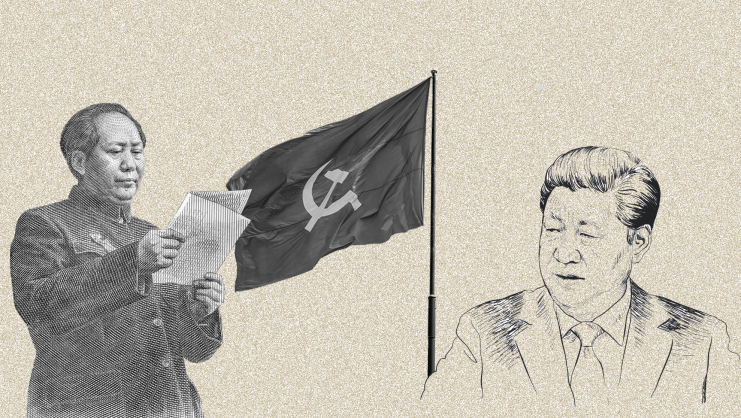Painting by Wei Zhu, Executive Director of the Tsung-Dao Lee Center of Sciences and Arts at University of Chinese Academy of Sciences; Director of the Science and Art Committee of the China Home of Nobel Laureates
While difficult to imagine today, it was not that long ago that China was barely considered a regional power. Yet in just a few short decades, the country has untapped its growth potential, lifting close to 800 million Chinese citizens from poverty and turning them into global consumers, thereby solidifying China’s long-term position as one of the most dominant global powers. As China continues to exert economic, political, and cultural influence around the world, its role in the global arena continues to take shape and expand. To understand – well, to begin to understand – this next stage of China as it transforms into a world leader, it’s necessary to consider the contemporary evolution of the country, from the business practices and national idiosyncrasies of Chinese firms to the country’s cultural renaissance and renewed focus on arts, education, and humanities.
An economic behemoth in the 21st century
The 2020 World Economic Outlook presented by the IMF indicated that China has displaced the U.S. to become the largest economy in the world. According to the yardstick refined by the IMF and CIA, namely PPP (purchasing power parity), the report shows that China’s economy ($24.2 trillion) has now exceeded that of the U.S. ($20.8 trillion). Although much of the mainstream press still considers the U.S. the top economic powerhouse at this moment, with all existing metrics, the fact that China’s economy will surpass the U.S. economy is inevitable. In creating the largest economy, China has become the biggest trading partner for most of the world’s major economies, and this will evidently reshape the relationship between China and these nations. For example, China has recently become the biggest trading partner of the European Union, after years of being second to the United States. In 2020, the trade of the EU with China was $709 billion, compared with $671 billion with the U.S. With the efforts of an efficient strategy for handling the challenge of the COVID-19 pandemic, as well as proceeding one of the fastest vaccination rollouts, China’s economy was the only major global economy with a growth in 2020 and will continue to be one of the major engines for the world economy in the post-pandemic era.
As Brazil’s ambassador to China explains, China is simply a more reliable trade partner.
Driven by reasons of economic security, China has dedicated considerable resources over the last decade to strengthening its relationships with Africa, Latin America, and the Caribbean. China’s growing middle class is steadily becoming the top consumer of Latin American products, demanding oil from Colombia, copper from Chile, and beef from Uruguay. A key attribute of the Chinese Communist Party is the Belt and Road Initiative, introduced in 2013 and officially initiated by the government in 2015, with the goal of enhancing regional collaboration and the trade network. As of early 2021, 19 Latin American and Caribbean governments have joined the $1 trillion transcontinental trade network and this not only points to China’s growing influence as a trade partner but will secure favorable economic opportunities among the participated countries for decades to come.
Other ambitious infrastructural projects, powered by China, are underway, such as proposals for transcontinental railways linking the Atlantic and Pacific coasts from Brazil to Chile, and a $3 billion port in Peru that is being constructed by a Shanghai-based shipping company. As Brazil’s ambassador to China explains, China is simply a more reliable trade partner, with which a mutually beneficial relationship can be easily built, hence it is paramount for countries to continue building trust and relations over time.
Chinese approach to business management
Given the drastic economic changes since the turn of the century, Chinese companies have experienced unprecedented turbulence and institutional turmoil due to the fast economic reformation, the fast-paced growth, and the global competition. Chinese business leaders have thus learned to cope with unpredictable business environments and constantly adapt to quickly evolving business systems. This agility is coupled with the unique cultural tendency to treat organizations as families. Chinese managers nurture their employees as they would their children and, in return, they make demands on them that go well beyond what the job description entails and as a result, Chinese firms operate like tight-knit family units in which loyalty, dedication, and interpersonal trust are the pillars of stability. This phenomenon translates directly into the harnessing of the key skills necessary to secure local government grants, investment funds, and navigating through bureaucratic red tape, as well as passing businesses down generations.
Chinese companies also differ from Western businesses in their strategic mentality. They tend to value high asset turnover and making key decisions at opportune times. There is a preference for very simple and hierarchical organizational structure, a deep reliance on strong personal ties with useful business and political actors, and an avoidance of debt (due to past instabilities), which leads to ballooning cash holdings. Defined by having extremely high aspirations and an openness to uncharted territories, successful Chinese firms have perfected their ability to constantly produce new products and venture into unrelated businesses, while maintaining high growth and fast pace. More and more Chinese brands become known to consumers around the world.
Chinese cultural renaissance
As China moves from a planned economy to a market economy and increasingly embraces private enterprises, those institutions that focus on the arts, humanities, and education have also received a drastic boost in autonomy and funding opportunities. The Chinese central government is advocating for free entry for visitors to cultural facilities across the country, including more than 50,000 museums, galleries, libraries, and cultural centers. There has been a huge push in the past decade to revitalize the public’s appreciation and passion for the arts, evidenced in the large increase in funding and grants available to traditional and performing artists, art communities, and educational institutions to establish art centers. Furthermore, the ministries of culture of other countries, especially those in Europe, Asia, and Australia, have drastically increased performance tours in China in recent years.
Investments made in the communication of art, culture, and education will bring a more vivid China to the world.
The overarching goal of the Chinese cultural renaissance is to not only elevate the influence of artists based in China, but to transform China into a cultural hub for the entire world. In the past 15 years, China has constructed some of the world’s largest and most well-equipped performing arts centers, and the efforts continue. One noteworthy new directional shift in many major Chinese universities is to develop contemporary and modern arts programs and schools, especially those with an interdisciplinary focus. For example, the University of Chinese Academy of Sciences recently established the Tsung-Dao Lee Center of Sciences and Arts to advocate for the interconnectedness of fine arts and the physical sciences. While art schools are traditionally separated from other academic fields, this growing trend has paved the way for domestic and international students to gain a newfound respect for the arts. In the past decades, Chinese international students have become a major income source for universities in the United States and in Europe. Yet, little attention has been paid to the fact that the international students at Chinese universities have likewise experienced a boom in numbers.
Marking the CCP centenary
Looking back at the past 100 years, China has experienced wars, poverty, famine, economic reformation, and the development of relationships and collaborations with other counties around the world. As a country of 1.4 billion people, and having experienced so many changes in such a short period of time, it is critical for the Chinese government to prioritize well. That said, in the 1970’s the Chinese Communist Party (CCP) positioned of upmost importance both economic reformation and the improvement of the people’s lives. This brought Chinese businesses into the global competition as well Chinese consumers to the global market, thus making the Chinese economy relevant to the world outside its borders.
This transformation also motivated Chinese companies to engage in a global dialogue, providing an opportunity to communicate the Chinese philosophy of business practice and to share Chinese points of view and form collaborations with the rest of the world. From a macro perspective, these collaborations serve as engines for the CCP’s Belt and Road Initiative, building connections along the trade network. In addition, what is more urgent than ever, is for countries to endeavor to gain mutual understandings, build trust, and develop collaborative relationships in order to face common human battles such as global warming, nuclear waste, the threat to biodiversity, the gap between rich and poor and the redistribution of wealth. Investments made in the communication of art, culture, and education will bring a more vivid China to the world, not just the economic power that has been emphasized by the media. And in turn, this more complex and nuanced understanding of China will help open the doors for Chinese people to understand and embrace the world.
© IE Insights.






